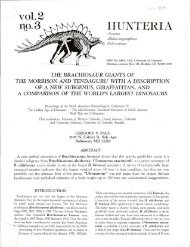THE MANY MYTHS, SOME OLD, SOME NEW, OF ... - Gregory S. Paul
THE MANY MYTHS, SOME OLD, SOME NEW, OF ... - Gregory S. Paul
THE MANY MYTHS, SOME OLD, SOME NEW, OF ... - Gregory S. Paul
You also want an ePaper? Increase the reach of your titles
YUMPU automatically turns print PDFs into web optimized ePapers that Google loves.
72 G. S. PAUL<br />
to be bowed outwards, with the femur substantially everted (this can be seen in the<br />
rear views of ungulates and ostriches in Muybridge, 1887). Femoral eversion may<br />
increase as the femur is protracted to clear the belly, or it may be constant. Typical<br />
eversions are 10 to 25°. It is as high as 45° in swans, which must run fast to take off.<br />
However, the trackway is still narrow, so the gait is effectively erect. Elbows also are<br />
often bowed outwards, and wrists and knees are bowed a little inwards, in birds,<br />
ungulates and carnivores. Most dinosaurs follow this pattern (see Figure 2). Elephant<br />
limbs slope down and inwards, and sauropods and stegosaurs are rather like<br />
this. The false belief in strictly vertical mammal and bird femora can lead to<br />
misinterpretations and misunderstandings of archosaur limb action, especially<br />
pterosaurs (see below).<br />
BIRD FEMORA ARE ALWAYS HELD HORIZONTAL AND IMMOBILE<br />
Myth: Birds have unusually short femora, and it is generally assumed that these are<br />
held horizontal and relatively immobile during locomotion (Cracraft, 1971; Galton,<br />
• •<br />
Figure 2 A multiview skeletal restoration based primarily on large USNM 4842, which is either<br />
Triceratops or Torosaurus (here fitted with the scaled up head and presacrals of T. horridus USNM 4928).<br />
It is shown walking out a large Laramie Formation trackway (from Lockley and Gillette, 1989; calculated<br />
speed 2.4 km/h) that probably belongs to one of the two taxa. Especially note that the right and left manus<br />
prints, which are somewhat lateral to the pes prints, are separated by only one and a half times their own<br />
breadth, and that they are directly beneath the ceratopsid's shoulder joints. The partial outwards turning<br />
of the manus prints shows that the elbows were not strongly bowed outwards (although they, and the<br />
knees also, are somewhat bowed outwards). These points confirm that big ceratopsid forelimbs were<br />
normally fully erect. The gauge of the forefeet may have decreased as speed increased and the substrate<br />
became firmer, while the arms may have become less erect during intraspecific head-head contests.<br />
USNM 4842 and trackway are to same scale, bar equals 1 m.









